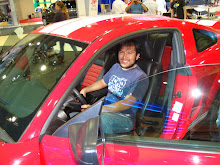The first safety belt used in cars was made in 1959, this is the safety item that have safe more lifes. Using safety belt you can reduce 75% of the damage in car accidents. In the begining of the century, some motorbike riders realized that using seat belts in the waist helped them to stay in their bikes. So in 1907 they patent the first safety belt for motorbikes. Volvo's engineer Nils Bohlin made in 1958 a 3 point safety belt. This belt sorrounds from the waist to the shoulder. This was the first safety belt for cars.
Most seat belts are equipped with locking mechanisms (or inertia reels) that tighten the belt when pulled fast (e.g. by the quick force of a passenger's body during a crash) but do not tighten when pulled slowly. This is implemented with a centrifugal clutch, which engages as the reel spins quickly. Alternatively, this function may be secured by a weighted pendulum or ball bearing: when these are deflected by deceleration or roll-over they lock into pawls on the reel.
In North America, cars sold since the early 1970s have included an audiovisual reminder system consisting of a light on the dashboard and a buzzer or chime reminding the driver and passengers to fasten their belts. Originally, these lights were accompanied by a warning buzzer whenever the transmission was in any position except park if either the driver was not buckled up or, as determined by a pressure sensor in the passenger's seat, if there was a passenger there not buckled up. However, this was considered by many to be a major annoyance, as the light would be on and the buzzer would sound continuously if front-seat passengers were not buckled up. Therefore, people who did not wish to buckle up would defeat this system by fastening the seatbelts with the seat empty and leaving them that way.
By the mid-1970s, auto manufacturers modified the system so that a warning buzzer would sound for several seconds before turning off (with the warning light), regardless of whether the car was started. However, if the driver was buckled up, the light would appear, but with no buzzer. New cars sold in the United States in 1974 and the first part of the 1975 model year were sold with a special "ignition interlock", whereby the driver could not start the car until the seat belt was fastened; however, this system was short-lived.
Today, the belt warning light may stay on for several minutes after the car is started if the driver's seat belt is not fastened.
In Europe and some other parts of the world, most modern cars include a seat-belt reminder light for the driver and some also include a reminder for the passenger, when present, activated by a pressure sensor under the passenger seat. A Swedish study showed that of the cars with seat belt reminder 8 of 10 drivers not using the seat belts were driving an Audi.
Some cars will intermittently flash the reminder light and sound the chime until the driver (and sometimes the front passenger, if present) fasten their seatbelts, and they sometimes even lock the speed to 10 km/h or less.
Subscribe to:
Post Comments (Atom)


No comments:
Post a Comment